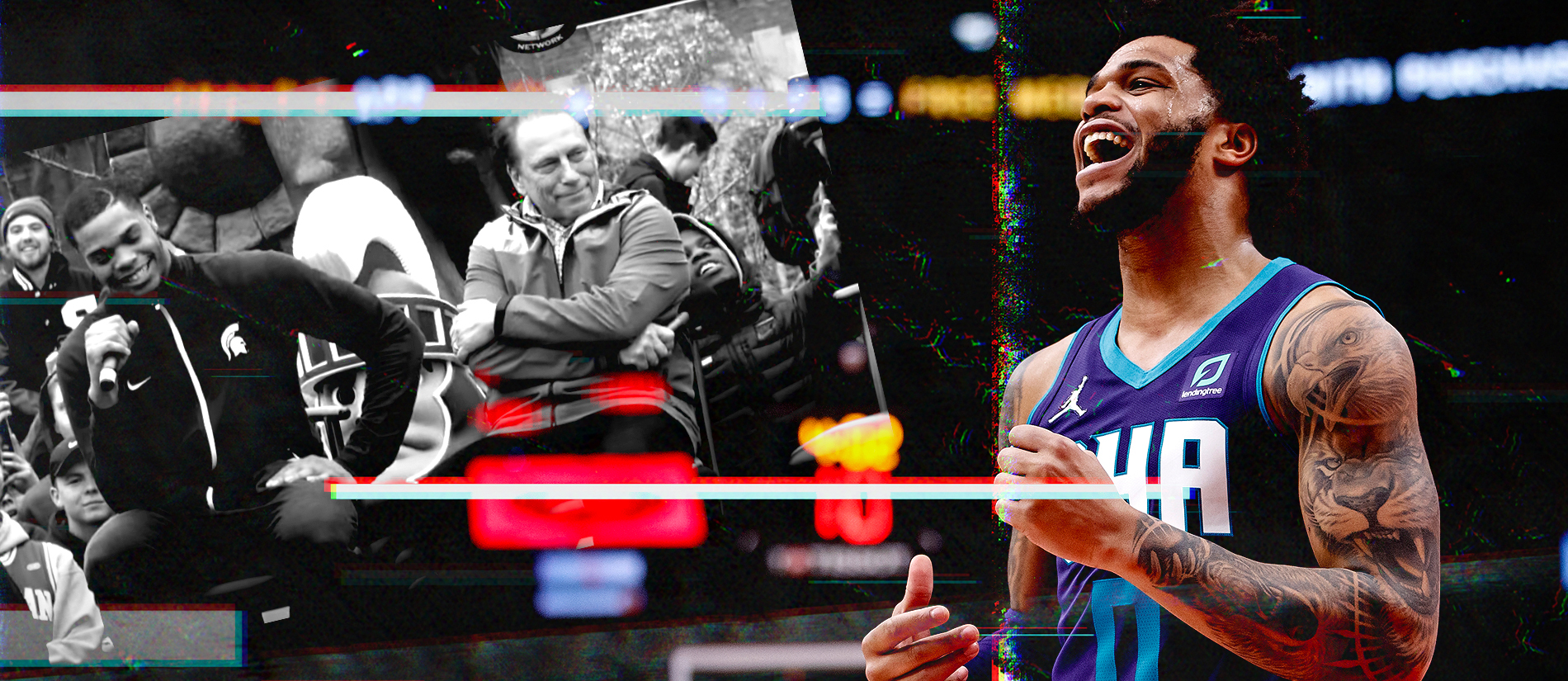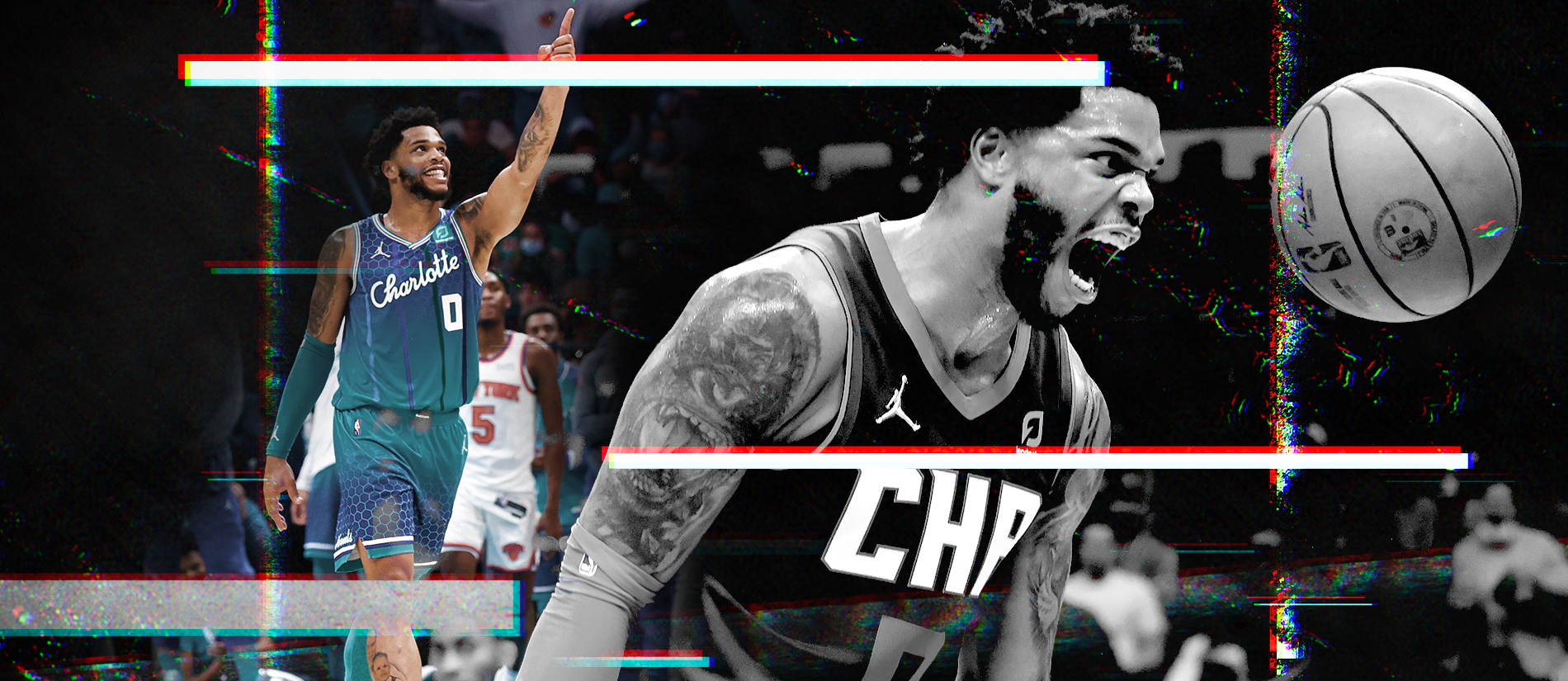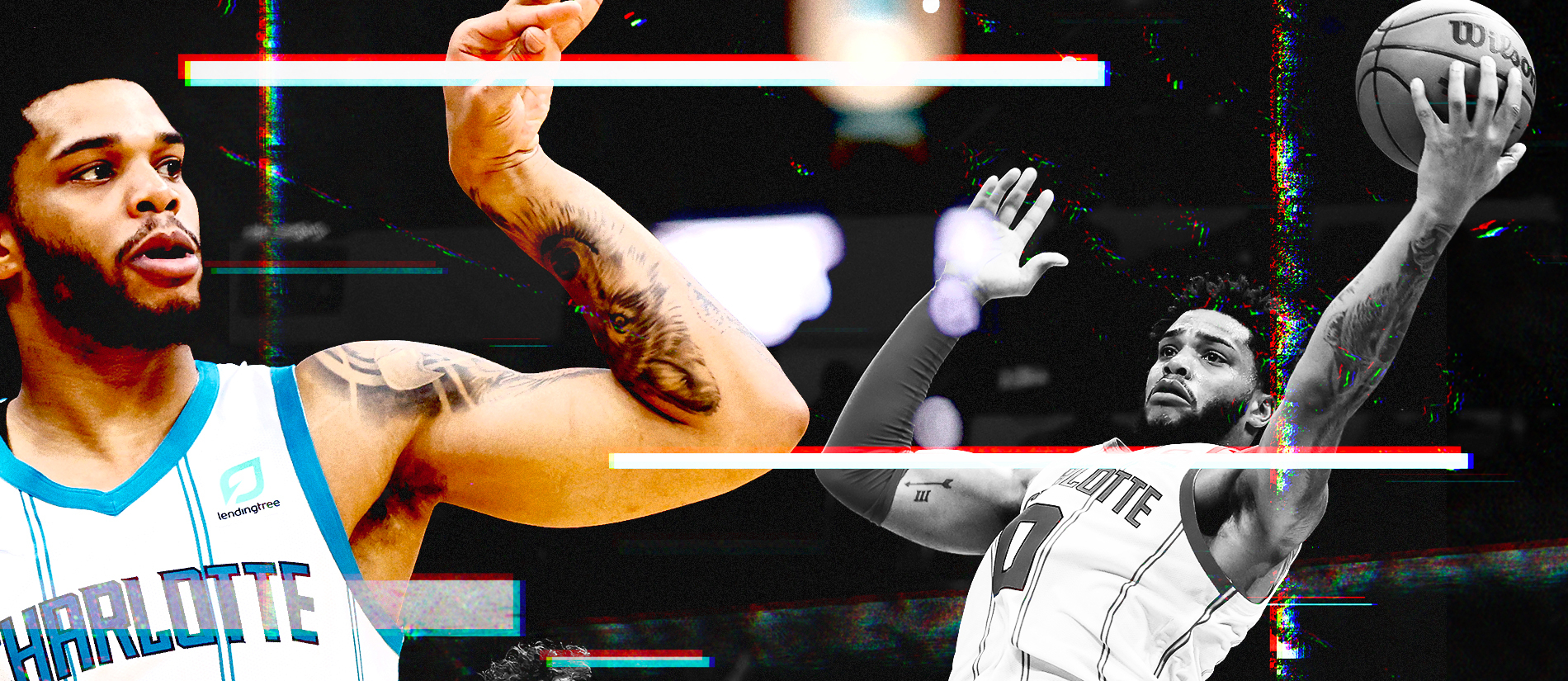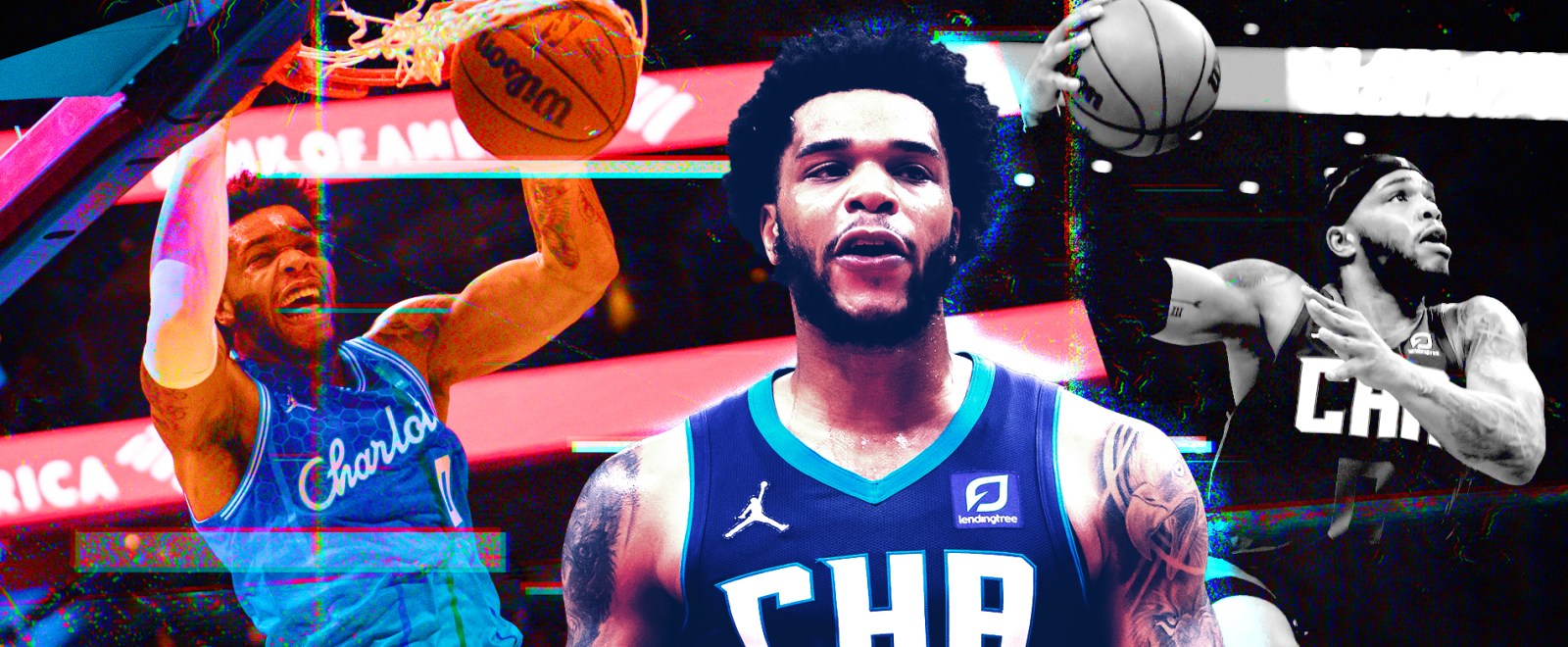Raise high the roof beams, analysts, because Miles Bridges is about to smash through the ceiling.
Sappho had Ares in mind when she penned the Archaic poem, and while Bridges’s dunks, raining down hard on the heads of Steven Adams, Clint Capela and Dennis Schröder, feel ferocious, it would be inaccurate to bracket him alongside the Greek god of war, who was all heady savagery, no exactitude. Because the ball, in the hands of Bridges this season, hasn’t only become a weapon, a variable heat-seeking missile intent for the basket, but a wrecking ball against any preconceived expectations, a bouncing beacon for quiet ambition, and a conduit of opportunity for his teammates.
In his fourth season with the Charlotte Hornets, Bridges has seamlessly made the jump from second option to starting mainstay. Toggling fluidly between offensive assignments inside and out, and defensively being asked to dig in at the five against against some of the league’s strongest, Bridges has been able to capitalize on his athleticism and strength while evolving entirely new facets of his game.
Watching Bridges — swapping from his dominant left hand to right mid-air for snaking layups, getting vertical on a dime for dogmatic blocks, unhurriedly shaking Kevin Durant for a step-back three — it can be tempting to assign his ease and brightness as inevitability, but doing so would discount the more difficult thing. Every step Bridges has taken, from his controversial choice to stay a second year at Michigan State down to lifestyle adjustments like hiring a personal chef, has been in service to a wider ambition. To play not just good, competent and flashy basketball, but to invest in his own longevity by honoring the work it took to get here.
“I was raised in Flint. I wouldn’t say it’s a bad community, but there’s a lot of violence there,” Bridges says on a call with Dime during the Hornet’s recent road trip. “Seeing my mom being able to take care of me and my sister. And my dad, when I was younger, showed me that any position that you’re in, you can make it out of.”
“What I learned from my family is how to keep going in life,” Bridges says.
There was plenty of second-guessing Bridges’ choice to stay with the Spartans for his sophomore season, rather than declare for the NBA Draft. Reporters made the trek to Michigan State, an hour and a half drive west from Detroit, to trail Bridges and his teammates around campus for clues, as if embedded in sociological fieldwork. But considering Bridges had turned down offers from Oregon, Kentucky, Kansas and others, the answer was actually pretty simple.
“I loved Michigan State my whole life. I was away from home for three years at Huntington Prep, so, with the team coming in, Cassius Winston, Tum Tum [Lourawls] Nairn, Josh Langford, Nick Ward, I had guys that I knew going to Michigan State, so I’d be comfortable there,” Bridges recalls. “I just wanted to go home.”
Bridges wound up on so many Big Ten and All-American lists at the end of his freshman year at Michigan State that a high Draft position for him was assured, but as he would eventually tell Spartans coach Tom Izzo on a trip to Cynthia Bridges’ (Miles’ mom) house in early April 2017, he didn’t feel like he was ready. He wanted to stay.
“I almost drove my car off the highway,” Izzo recalls over the phone with a laugh, “Long story short, he told me he wanted to stay to win a championship. I told him that was a bad idea, because it’s such a long shot to win one.”
During the remainder of that drive, Izzo pressed his young star for a deeper explanation, sensing his trepidation. Bridges eventually told his coach that he wanted to get better, to be “mature enough and good enough” to ensure, as best he could, that when he got to the NBA he’d be skilled enough to stay there.
“When we did the announcement, he was just so classy and so humble,” Izzo remembers of the presser set up for Bridges to declare his intention to stay at Michigan State a second year. From the crowd — bouncing to keep warm in hoodies under Spartans jerseys — to the tentative magnolia buds on trees in the background, everything about the announcement was hopeful. Bridges, fidgety with nerves until he says he’s “got some unfinished business here, I’m just saying, I want to stay,” buries his head into his chest, grinning with relief.
“Like all of us, he had to grow,” Izzo says.
There is no trace left of that nervous freshman. With Charlotte, Bridges has become the team’s most vocal leader, leveling honest criticism about defense after losses or what could have been done better, while simultaneously encouraging his teammates to take care of their bodies, to rest, to get in the gym. Bridges credits his first vets, Kemba Walker and Marvin Williams, for teaching him “how to be a real professional in how to talk to your team and gather everybody around,” as much as he does that second year at Michigan State, when Izzo made him Captain of the team.
“Some guys lead by example, and that’s okay. I’m not big on leading by example,” Izzo says, when asked about naming Bridges a team captain. “I’m big on guys that lead by dragging people with them. By example, somebody’s got to be watching. And if they’re not watching, then you’re not really leading them. I was big on encouraging him to become more of a vocal leader, more of a leader that dragged other people with him. And if he thought that helped then I’m really excited, because that’s one of my big beliefs, in the maturation of an 18-year-old, a boy to get to be a man, to be honest.”

The Charlotte Hornets have broken audaciously into the NBA Playoff race this season. While due in no small part to the bluster and electricity of LaMelo Ball, deftness of Gordon Hayward, and adept roleplaying of Terry Rozier, the most crucial ways the Hornets have clicked this season have come from the surefooted versatility of Bridges.
To prepare, Bridges found himself where he does every summer, back in the gym with his trainer, Chris Johnson. “That’s the only way you get better,” Bridges says. “A lot of guys, they get complacent, but I just like to go in the gym and try to push myself past exhaustion every time.”
While the biggest personal jump for Bridges and boon for the team has come in his scoring ability — a recent career-high night against the Knicks saw him put up 22 points in the first quarter and 38 in the game — the more important numbers are in where else he’s helping. The Hornets are currently 3rd overall in assist ratio, at 27.2 percent, 4th in offensive rating at 112.4, and second overall in pace. For such a high-flying, offensively minded team, Charlotte’s best and brightest wins come when everyone in the lineup is getting their hands on the ball and working within the team’s clear chemistry and Bridges, with his intuition and explosiveness, has found fast success as a playmaker.
“He showed glimpses of being a decent passer in his first year, second year, and once we started seeing that it was like, instead of just, ‘Hey Miles, make this pass’, now let’s pull some plays for him,” Hornets assistant Dutch Gaitley says of the team working with Bridges to showcase his playmaking.
Gaitley notes that with Bridges playing the minutes he is this season (36 per game, 12th overall in minutes played league-wide) there isn’t “a ton of time for reps and practice”, so a lot of what Bridges is doing is mentally honing himself through film work. But Bridges has taken to the work so well that it’s got Gaitley and Charlotte’s coaching staff adding more.
“Now, we’re trying to add the part of drive left, can we still make those same passes? Which, him being left handed, you’d think differently, but he’s able to drive right, finish right, he’s able to drive left, finish left. Now it’s like, can we play-make going both ways?” Gaitley says, his voice falling into a fast rhythm. “He’s a great finisher at the rim, he can shoot threes, now we can add the playmaking aspect to it, and now we can really add a lot to his game.”
“We put the ball in his hands a ton,” Hornets head coach, James Borrego, said of Bridges playmaking after the team’s win in New York. “Miles is one of those guys that can make plays off the bounce to score for himself or getting to the rim. Obviously, he is elite getting to the rim but he’s also done a great job playmaking for us, making decisions — putting the ball in his hands to create, kick to a teammate or go finish.”
For his part, Bridges sees the ball being in his hands more this season as a responsibility to his team: “I have the points and I have the rebounds, but if I can’t set up my teammates, then I’ll be liability on the court, ‘cause that’s how we play.”
It’s Bridges’ egoless approach to the game, and where he fits into it, that’s clear when he talks — preferring to speak with greater emphasis and praise about his teammates and staying succinct when it came to himself — and that came up unprompted in conversations with the people around him.
“He gets along with people,” Izzo says. “I can’t think of a teammate he didn’t get along with — even the opposing team. Miles was an incredible worker. Some superstars, especially when they come in as top-10 picks, McDonald’s All-American, they just play on their talent. Miles was one of the more humble guys I’ve had, maybe the most humble guy with the talent that he came in with. That’s what made it so much fun to coach him. He was truly a team guy.”
Izzo also noted that Bridges never shied away from people “telling him the right thing, not just what he wants to hear” during his time at Michigan State, or later, when Borrego might text Izzo to say he needed more out of Bridges. Izzo likened that unflinching approach to honesty to another former Spartans alumni and close friend of Bridges, Draymond Green.
“He’s got a different personality than Draymond, but what he’s got [in common] is that ability to sacrifice to win,” Izzo recalls. “Winning is important to Miles. It wasn’t him getting 30 points. He just wanted to win. There are so few people like that now, where winning is the priority. Everybody says it is, probably 90 percent. I think that’s one thing he learned from Dray, just be a good winner.
“Being a winner and being a good teammate, those are skills. They’re just like having a good jump shot.”
Gaitley, who was brought on by Borrego in May 2018, began working with Bridges in his second season, and noted his willingness to accept that there were gaps in his game and take that on as a challenge to get better.
“I think the willingness to hear my suggestions of hey, this is where you have to improve, and him being comfortable being vulnerable,” Gaitley says. “Comfortable saying, I do need to get better at these things, I can’t be a two-foot finisher my whole career. I need to improve jumping off my right leg, jumping off my left leg. And I may have to sacrifice a couple catch-and-shoot threes for passes for my teammates, knowing that it’s going to come back on the other end.”
And for Bridges, it’s come back in spades. He’s frequently the outlet for some of Ball’s handiest no-look passes, which he’ll punctuate with an emphatic dunk or tricky hook shot, as he is the off-ball option for Rozier, Cody Martin, and Hayward. In terms of collaborative spacing, Bridges will apply relentless pressure at the rim one possession only to slip out beyond the arc in the next, all as if to say, there isn’t going to be a safe place you can put me.

Where the Hornets tend to glitch is on defense. Turnovers, unnecessary fouling, and untethered rotations are often a calling card of young teams, and Charlotte’s tend to come when the team gets a step ahead of itself in transition, or the pace proves too breakneck.
“The main thing defensively for him, and for all young players, is the off the ball stuff,” Gaitley says, “I think Miles, when it’s a one-on-one drive and we’re playing ISO guys, he does a great job of shoving his hand and using his chest to be physical. But off the ball, they’re running a pick-and-roll and your man’s not involved, [so] what is your rotation? And the only way to learn that is with reps and with time.”
“You gotta know what the defense is giving you each night, cause there’s 29 different defenses [you’re facing] in the NBA,” Bridges says, adding, “Knowing guys tendencies, knowing how they play, knowing what they want do. Me being locked in on the mental side helps me with that.”
Still, a silver lining is that most of the Hornets errors are the result of the team being self-generative, pushing beyond what’s comfortable. Gaitley makes the point that defensively, the team does that with Bridges by giving him such a wide range of assignments that he might cover everyone on their roster just to get a feel for what each coverage requires.
“He does a good job of understanding what our schemes are, where we want to force guys on the floor,” Gaitley says. “Now it’s combining the schemes plus the physicality. Not just doing one or the other. Not being overly physical and maybe getting fouls. How do we mesh both of those so that we’re doing what we want to do defensively, but also doing it physically?”
Coach Izzo sees it too.
“He came in as a three man, but then we had all these injuries,” Izzo says of Bridges’ time in East Lansing. “So he had to play the four, he had to cover big guys, small guys. I think that started here. But then you get to the pro level, and those guys are so much better.”
Where modern, young teams like the Cavaliers and the Raptors are shifting toward positionless play, stacking rosters with 6’9” stretch bigs with wingspan to spare, the Hornets have a unique anomaly of power and speed in an “undersized” athlete like Bridges. At 6’6, he shouldn’t have the reach but is averaging 7.4 rebounds per game anyway; at his strength, he shouldn’t be the one flying down the floor in transition, nimbly converting a striped ball into a wide open dunk, but is, leaving dumbfounded defenders in his dust.
On top of it all, Bridges has the torque and control closer to a gymnast. Making contorted plays — like when he shook three defenders, lobbed the ball up to hang, and met his own pass at the rim to finish — look graceful.
“There’s times where you watch on the court and you’re like, man, guys are bouncing off him left and right,” Gaitley says of Bridges athleticism, “We joke around in his pre-game warm-ups, we do one move where he shoulder bumps me, and I’ve started to exaggerate and throw my body into the basket stanchion. But there’s times when he’s caught me with a couple of shoulders to the chest and I gotta take a break and say take two free throws, let me catch my wind.”
When something is so intrinsic, so habitual, it can be hard to break it down outside of the body doing it. From his perspective, Bridges is just moving naturally, even if it might look like his steps are choreographed.
“Ahh,” Bridges sighs, when asked to at least try to explain how he’s able to read and react to the game from such a wide lens. “I mean, I really can’t explain it. It’s hard to make decisions within a split second. I think it just comes from me playing basketball all my life, and me knowing the game. I play off instincts most of the time.”
Cerebral is another way to describe players who are able to read the game and adjust themselves to action as it comes, plus preempt what their team needs, as if two steps ahead. Asked if that’s a correct assessment to give Bridges, and Gaitley replies quickly, “Absolutely.”
“Going from small-ball five to the four, to maybe even three, and that’s maybe only on offense. Now we’re going to put you on [Dennis] Schröder, now we’re going to have you guard LeBron [James], now you’re on Russell Westbrook, now you’re on the five. Those things are not easy to do,” Gaitley stresses. “He was not capable of doing this his rookie year. His rookie year, we said you have to stay on the three because it was going to be hard. There’s so much room for improvement for Miles, the sky’s the limit for him. We wouldn’t throw all this stuff at him if he wasn’t showing success in those different roles.”

Since last season, when the team was fourth in the East until much of the roster went down with injuries or with COVID, Charlotte’s been moving toward one pointed objective — the postseason. Poised, in Bridges’ words, to “make some noise” if they get there, it’s not a stretch to say that so long as the team clamps down on where it bleeds points and momentum in defense, and up their free throw percentage, they will.
Teams like the Hornets and players like Bridges, who are used to flying under the radar, find the work of proving people wrong a blue-collar part of the job, something steady, rather than emotional.
“I usually have, like, what? Five good games and throw in a bad game here and there,” Bridges says. “I’d like to just throw those bad games away.”
That on to the next mentality makes Charlotte a ready bounce-back team, not putting too much weight on the wins or the losses, just the next one. As the sixth-youngest team in the league, the Hornets have energy to spare for the ups and downs now, but staying power takes endurance. From now until April, Bridges wants the same thing out of his game as he does his team.
“We’re a young team, but that’s still no excuse, because we’ve been together for more than a year. I think what we have to get better at is being locked in, finishing games, and limiting our fouls. If we limit our turnovers and play the game the right way, I feel like that’s when we win,” Bridges says, adding lightheartedly. “We’re 30th in the NBA in defense, so, we definitely gotta get better at that too.”
Regardless of how the rest of the season shakes out for the Hornets, Bridges is in a contract year, and like his last big decision, this will determine where he goes next. Izzo, who says Bridges called him at the beginning of the season to say he was going to have a good year, sees his former player making his next big choice the same way he always has.
“He’s putting himself on the NBA map right now, and he’s done it by working his way there and not getting all the accolades,” Izzo says. “It’s got a lot to do with his teammates, with his coach there. And it’s got a lot to do with Miles.”
Hindsight is not always 20/20, sometimes it’s a funhouse mirror, or a completely parallel reality.
In his media day presser before this season, Bridges was asked whether he expected to get many minutes. Go back even farther, to his Draft scouting reports, and Bridges was billed as a potential role player, but without much chance of turning into a high-level scorer or All-Star. Four years in, to little fanfare but as the result of that stake in his own longevity, Bridges is poised to see career scoring and was top-10 in fan voting for All-Star.
“As far as those guys that rank him, they can only rank the skill they see,” Izzo notes diplomatically, when asked about the initial limitations placed on Bridges. “They don’t rank the six o’clock in the morning workouts, or him in the weight room. They don’t rank him in a locker room after a bad loss, and how he feels and how he takes it. And they don’t rank him as far as what he’s like in a huddle when it’s winning time — ‘Coach, I can make this shot’. Those things never get ranked, but they’re very, very, very important things.”
But the best part of the NBA is once a player gets there, rankings go out the window.
“I think his best basketball is still ahead of him,” Izzo adds.
And with the way Bridges has widened his scope, and lifted his ceiling, there’s no point in calling it a prediction. It’s as true as ancient history.







